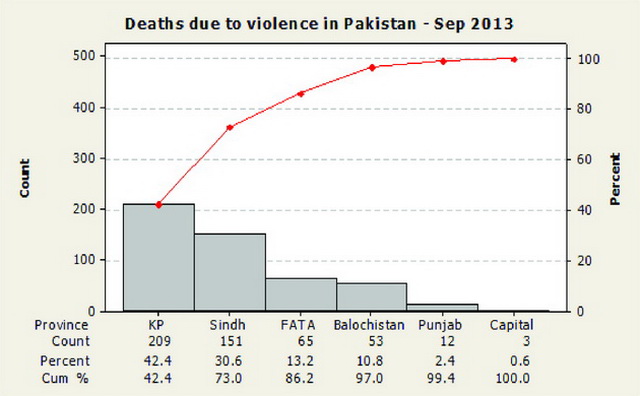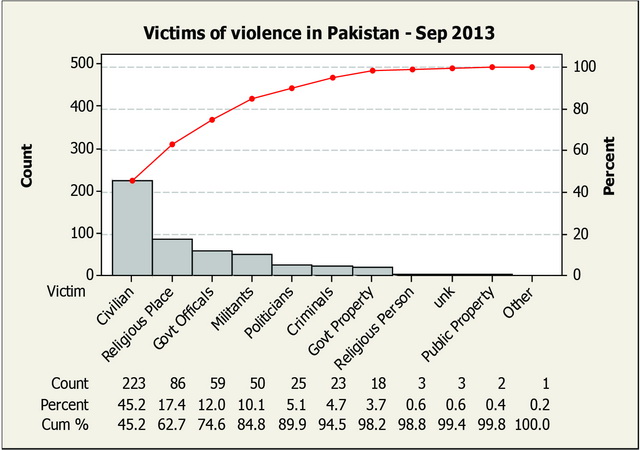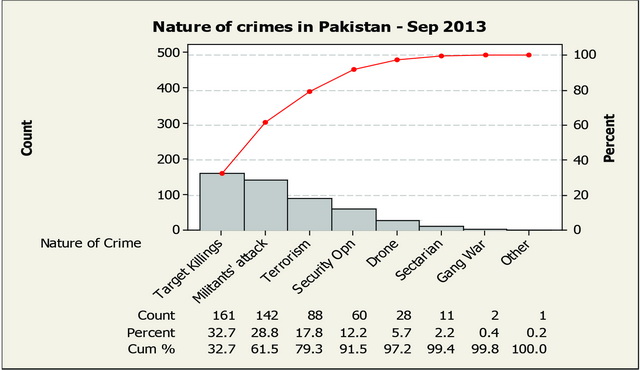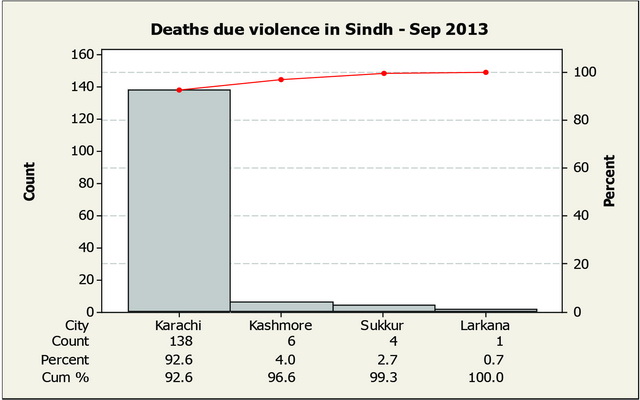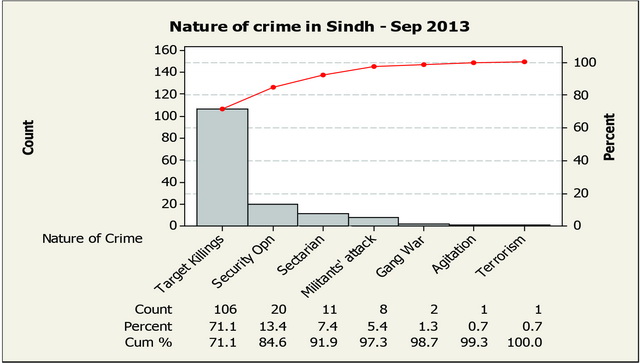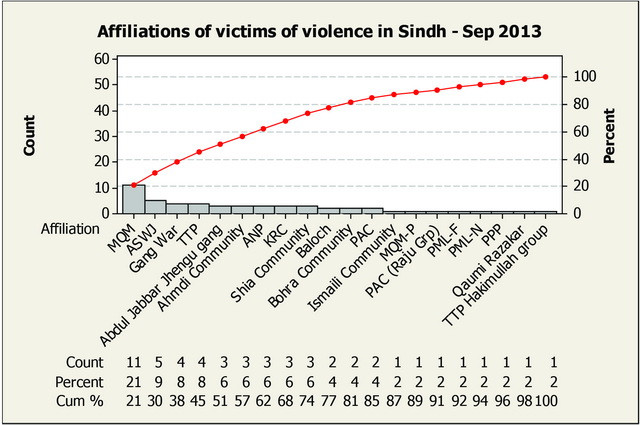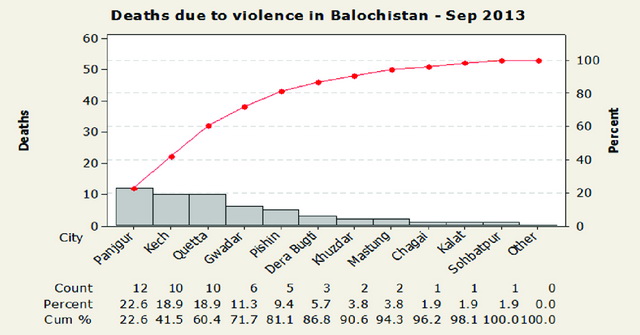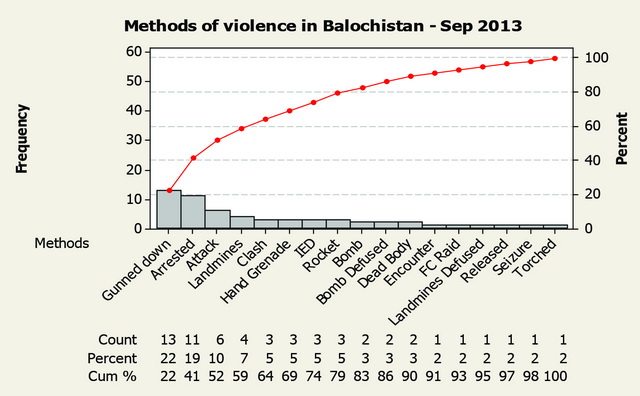MONTHLY REPORT ´ September 2013
Holding of the long-awaited All Parties Conference (APC) on September 9 was a major development in terms of efforts Prime Minister Nawaz Sharif recently elected government has undertaken to tackle, through peaceful means, insurgent and politically-motivated violence plaguing Khyber Pakhtunkhwa (KPK), Balochistan, the Federally Administered Tribal Areas (FATA) and the country commercial hub, Karachi.
While participants agreed to seek an end to the problems through peaceful negotiations, the joint resolution issued after the APC failed to clearly identify stakeholders on the other side and whether such parleys would be held under Pakistan constitution. The vague outcome provoked the media to severely criticize the government and commentators even condemned it as surrendering to those using violent means to propagate their cause.
The peace overtures, however, were not enough to dissuade terrorists from violence. Peshawar and its surrounding areas in particular witnessed some of the deadliest attacks in the later part of September. They included a twin suicide bombing on the All Saints– Church in the city that left more than 85 members of the minority community dead, nearly half of them women and children. Christian sources claimed the death toll to be around 120.
All these events and other facts reported in the national newspapers are collected to make this report as informative and factual as possible. Errors and omissions, as always a possibility in all statistical works including this one, are expected. However, such mistakes do not grossly affect the basic objective of this report. This report mainly covers the following topics:
Violence and APC resolution
Violence in Sindh
Violence in KPK and FATA
Violence in Balochistan
Drone attacks
CRSS will appreciate receiving comments that the readers may have on this report.
Report prepared by:
Mohammad Nafees
Senior Research Fellow
Center for Research and Security Studies
Data compilation by:
Fariha Farry
NOTE: Readers can approach CRSS for source of any information included in the report. Please send your request to: mail@crss.pk or zaheer@crss.pk
OVERVIEW
Deaths due to violence in the country during September 2013:
September turned to be the deadliest month so far this year.The total casualties of violence during September touched the figure of 1048 persons (493 died and 555 injured), an increase of 35% compared to 774 casualties in August (432 dead and 342 injured). More than 50% of total casualties took place during the last nine days of the month (22 ´ 30 September) when 240 persons died and over 370 persons were injured throughout the country.
Graph 1: Deaths of violence ´ Jan ´ Sep 2013
Table 1: Deaths of violence ´ Jan ´ Sep 2013
| Month |
Killed |
Injured |
Total Casualties |
| January |
591 |
373 |
964 |
| February |
454 |
324 |
778 |
| March |
570 |
392 |
962 |
| April |
429 |
544 |
973 |
| May |
622 |
914 |
1536 |
| June |
616 |
535 |
1151 |
| July |
572 |
642 |
1214 |
| August |
432 |
342 |
774 |
| September |
493 |
555 |
1048 |
Graph 2: Number of people killed in provinces due to violence:
Among all other provinces, the death toll due to violence was the highest in KPK during the month of September, while Sindh recorded the second highest number of deaths followed by FATA and Balochistan. From a figure of 84 persons that KPK and FATA recorded last month for the victims of violence (38 died and 46 injured), it jumped to 707 casualties (274 deaths and 429 injuries), eight times higher than those occurred in August. Violence-related incidents killed a total of 374 people in both Sindh and Balochistan province, a marked decline of 40% in such deaths compared to previous months. (See graph 2).
On district level, Peshawar lost more lives than Karachi during the month in review, while Quetta, too, saw far lower number of deaths in September. (See graph 3). A review of this change will be discussed in other chapters. Click Monthly Report to access violence data for the month of August.
Graph 3: Number of persons killed in cities:
The majority of the victims was civilians. In September, two places of worship, a Church and a mosque or Imam Bargah for Shiite Muslims were attacked. The two important pillars of the state, government officials (including army personnel, FC personnel, and policemen) and politicians (including activists and supporters) also suffered 84 deaths, more than the militants and criminals together (73 deaths) during this month (Refer to graph 4).
Graph 4: Victims of violence in September 2013:
While most of the incidents of targeted killings happened in Karachi as usual, Balochistan, KPK, FATA, and Gilgit-Baltistan (GB) regions have been bearing the brunt of militant, sectarian and terrorist attacks (Refer to graph 5).
Graph 5: Nature of violence in Pakistan ´ September 2013
Violence and APC resolution:
To address the menace of these crimes, the government came out with a plan to convene an All Parties– Conference (APC) on 9th September 2013. Soon after the date of the APC announced, a debate ensued among different political parties and opinion makers offering suggestions and evaluating the possibility of the effectiveness of an endeavor that was tried earlier too and had no or very little results in the past.
Jamat-e-Islami called its own APC on 4th September and came to a conclusion that the USA is the real enemy of democracy[1]. Head of Jamaatud Daawa (banned by the UN and US) Hafiz Muhammad Saeed welcomed the idea of holding APC and suggested that the role of India in acts of terrorism in the country should be made part of the agenda[2].
Pakistan Tehreek-e-Insaf Chairman Imran Khan showed his willingness to attend the government-sponsored APC and said he would put the four-point agenda of his party before the conference for discussion and approval. This agenda included:
– Quitting the US war on terror
– Begin dialogue process with the Taliban (without specifying though as to which Taliban groups to talk to)
– Truth and reconciliation efforts (to prevent the jobless and unemployed people from going astray in the affected areas of the country)
– Military operation only after convening an APC
The resolution passed by the APC on 9 September was unanimous on the following points[3]:
(a) The sovereignty and territorial integrity of Pakistan
(b) trust and confidence in our valiant Armed Forces
(c) Thousands of precious lives of innocent men, women and children and defense and security personnel have been lost in the war.
(d) Rehabilitation and social reintegration of these families and other victims of terrorism,
(e) Drones is not only a continued violation of our territorial integrity but also detrimental to our resolve and efforts of eliminating extremism and terrorism from our country.
(f) We and not the USA or any other country should guide us on how we shall fight this war.
(g) ‘Give peace a chance’ would be the guiding central principle and be the first priority.
(h) Grave concern the continued threat to life, property and business in the city of Karachi restoration of peace and order.
(i) Address the concerns of our Baloch brothers and sisters in the Province of Balochistan.
The resolution failed to define as to what political parties consider as the sovereignty and how they look at acts of violence carried out by armed militants on security check posts, army convoys, jails, public places and other government installations. While the resolution talked about the rehabilitation of the victims of terrorism and elimination of extremism and terrorism from the country, there was nothing to explain as to what was considered as an act of terrorism and extremism. While the participants were unanimous on negotiating peace with our ¿own people– in the Tribal Areas, their decision in dealing with our own people in Karachi was different. A grave concern was shown to the continued threat to life, property and business in the city of Karachi but no such concern was voiced when the militancy in KPK and Tribal Areas was debated.
Tehreek-e-Taliban Pakistan (TTP), the major group behind most acts of violence, and religious parties welcomed the APC resolution whereas reaction in the press was mixed. The News in its editorial called the declaration of the APC as a repeat of what the politicians have been talking about for years. It also criticized the leadership for having no ideas on how to deal with the Taliban[4]. A strongly worded rejection of any negotiation with the Taliban came from a senior journalist, Ayaz Amir, in these words: ‘In the Pakistan of today paralysis of thought and action is dignified by the name of democracy and covered by the cloak of consultations.’[5]
Since a consensus on targeted operation in Karachi was evolved during the APC, we would like to analyze the crimes committed in Sindh and other parts of the country and see where human lives and state sovereignty are more at stake.
Violence in Sindh:
Sindh lost 149 persons to various acts of violence during September 2013. 138 of them were from Karachi and the remaining were from Kashmore (6), Sukkur (4), and Larkana (1) (Refer to graph 6). Nearly 70% of the people were killed in target killings (106) and the remaining 30% were victims of security operation, sectarian attacks, militants– attack, gang war, and terrorism (Refer to graph 7). Militants– and sectarian attacks are basically related with the religious militancy that has its bastion in FATA, KPK, and Balochistan. From the identity of some of the victims of violence and the new methods of violence that began reported from Sindh very recently, it is easy to determine that the players in the crimes of Karachi are not confined to the militant wings of political parties alone. There are victims of violence in Karachi belonging to Ahl-e-Sunnat Wal Jamat (ASWJ), TTP, and TTP Hakimullah group (Refer to graph 8). Karachi lost 11 persons to the sectarian violence during September and the victims were belonging to Ahmadi, Shia, Bohra, and Ismaili communities. Nobody claimed responsibility for these sectarian attacks but they carry the footprints of those religious militants that are active in KPK, FATA, and Balochistan. All these incidents prove that blaming the three major political parties for the violence in Sindh is not justifiable and we have to look beyond a paradigm that carries a sign of political vendetta.
Graph 6: Deaths due to violence in Sindh ´ September 2013
Graph 7: Nature of violence in Sindh ´ September 2013
Graph 8: Affiliation of the victim of violence in Sindh ´ September 2013
Violence in KPK and FATA:
KPK and FATA lost the highest number of people (275) to the violence during September and 235 of them were killed after the unanimous resolution of APC that had recommended negotiation with the Taliban as the top priority. A timeline of major militants– attacks after the 9th September APC resolution shows the following scenario of militancy in this region:
September 14: Charsadda: 35 unidentified militants surrounded Sro check post in Shabqadar, Charsadda and fired rockets at the building before opening fire at police officials present there and killing one man and injuring another one. After going through an intense firefight for over 20 minutes, the militants retreated and on their way back killed a watching at a petrol pump and blew up a Government Boys Primary School in Musa Qilla by planning multiple bomb near the building[6].
September 14: A bomb explosion Saturday killed two members of a Pakistani pro- government militia and wounded four others in Khar[7].
September 15: The Major General Sanaullah who restored peace in Swat became target of a roadside bomb explosion in Upper Dir that was claimed to have been planted by the Taliban. Along with him died the two other military, Lt Colonel Tauseef and Lance Nayak[8].
September 15: Blast near security forces vehicle martyrs one in NWA MIRANSHAH: One security man was martyred and two wounded in an explosion that occurred near the forces vehicle on Miranshah-Mirali Road in North Waziristan Agency (NWA)[9].
September 16: Two soldiers killed in NWA blasts MIRANSHAH: Two soldiers were martyred and three others sustained injuries in separate explosions in North Waziristan Agency on Sunday, sources said[10].
September 16: BANNU: Two khasadar officials were killed and four other officials were injured when unidentified militants attacked their van near a check post in Frontier Region (FR) Bannu late on Saturday night[11].
September 18: MIRANSHAH: At least two militants were killed as security forces repulsed an attack on a checkpost in Dattakhel Tehsil of North Waziistan tribal region whereas one solider was also wounded in the attack that took place early on Wednesday[12].
September 20: PESHAWAR: Three people have been killed and 20 others injured on Thurday night in a hand grenade attack near a mosque in Sarband area late Thursday on the outskirts of Peshawar. Eyewitness Ulas Khan told Dawn.com that there was a religious gathering in the Pirano Mosque when the attackers entered, opened indiscriminate fire and then threw hand grenades after which they fled away[13].
September 22: Lower Dir: Pakistani security forces claimed to have killed at least 12 militants and injured many others when a cross-border militant attack was repulsed by them in Lower Dir district, two solider have also been injured in the clash. The security sources told that at least 15 to 20 militants crossed into Pakistani territory from Afghanistan. They attacked Pakistani security forces that were deployed there[14].
September 23: PESHAWAR: The death toll of twin suicide bombings at a church in Peshawar killed 81 persons (later this figure went up to 86 when some of the injured failed to survive). Among the dead were 34 women and seven children. Taliban Junood-ul-Hifsa claimed the responsibility of this attack.
September 26: BANNU: Terrorists launched a rocket attack on a security forces camp here in the Janni Khel area on Wednesday morning. However, security forces retaliated and killed five terrorists[15].
September 26: GHALLANAI: The under-construction Gandao Dam in the Mohmand Agency was damaged when militants attacked it early Wednesday, sources said. The militants also set ablaze vehicles, including two trucks, two excavators, three tractors and other machinery at the worksite. Meanwhile, three persons were killed and six others sustained injuries in an improvised explosive device (IED) attack when they were travelling towards the dam. The Tehreek-e-Taliban Pakistan (TTP) has claimed responsibility for the attack[16].
September 26: BATTAGRAM: Unidentified miscreants set ablaze the post office in the main market, police sources said on Wednesday[17].
September 28: PESHAWAR: A bomb tore through a passenger bus, carrying mostly government servants, on the edge of Peshawar, killing at least 20 people and injuring 43 passengers in the blast that happened on Charsadda Road[18].
September 28: BATKHELA: Seven persons sustained injuries in a stampede at a circus after a remote-controlled blast in Sakhakot on Friday, official sources said[19].
September 29: PESHAWAR: Twin blasts near the Qissa Khawani market in Peshawar on Sunday killed 41 people and wounded at least 103 others. At least 50 shops were either damaged or completely destroyed. Shahidullah, the spokesperson for the Tehreek-i-Taliban Pakistan (TTP), denied its involvement in this attack emphasized that the TTP was targeting only security forces and government functionaries[20]. Whether or not we believe what the Taliban said, the saddest part of these twin blasts was the loss of 15 members of a single family that included 8 females, 5 children, and two males[21].
Other than these major incidents of violence in KPK and FATA a comparative analysis of violent incidents in KPK/FATA and Karachi is also carried out to understand as to which region poses more threats to human lives and to the sovereignty of the country. The picture we get is tabulated in the table xxx below. The table clearly shows that KPK and FATA are not only affected of crimes that are more horrific and deadlier than the crimes committed in Karachi but are also detrimental to the integrity and sovereignty of the country. The Taliban admission of targeting only security forces and government functionaries is an example of how the sovereignty of the country is being targeted if our concept of the sovereignty includes humans and remained confined to the territorial boundaries.
Table 2: Comparative analysis of violent incidents ´ FATA/KP and Karachi
|
Comparative analysis of violent incidents |
Number of incidents |
|
|
Nature of incidents |
FATA/KP |
Karachi |
| Bomb blast incidents |
22 |
2 |
| Militants’ attacks |
11 |
1 |
| Bomb defused |
14 |
5 |
| Dead body found |
7 |
12 |
| Target killing incidents |
6 |
85 |
| IED incidents |
6 |
1 |
| Police Raid |
5 |
|
| Hand grenade attacks |
4 |
3 |
| Rocket attacks |
4 |
|
| Encounters between security and militants |
2 |
4 |
| Landmines |
2 |
|
| Landmines defused | ||
| Mortar shell attack |
1 |
|
| Rocket defused |
1 |
|
| Suicide attack |
1 |
|
Violence in Balochistan:
Balochistan had a sigh of relief this month when it experienced a significant reduction in deaths of violence. As against deaths of 138 person in the last month, there were 53 persons who lost their lives due to violence this month, almost 40% reduction in fatalities. However, unsuccessful attempts were made by the militants and insurgents to target high profile government officials during the rescue operation for the people of Awaran that were affected by the earthquake. Even the convoy the CM came under rocket attack during his visit to the earthquake affected area of Awaran. Nobody got hurt[22].
Unlike the previous record, it wasn–t Quetta but Punjgur that was highly affected of violence in Balochistan during this month (See graph 9). The methods of violence in Balochistan were as deadliest as they were in KPK and Sindh. Armed attacks, hand grenade attacks, use of bombs, landmines, IED, and rockets were the methods frequently tried by the militants but many of them remained unsuccessful the credit of which may be given to the security and intelligence agencies (See graph 10).
Graph 9: Deaths due violence in Balochistan ´ September 2013
Graph 10: Methods of violence in Balochistan ´ September 2013
Drone Attacks
The other agenda of APC that attained full support of the APC participants was to condemn drone attacks as the serious violation of sovereignty of the country and a suggestion was made to the Prime Minister, Nawaz Sharif that he should take up this issue at the UN level during his upcoming visit. Prior to the PM speech at the UN, the US President Mr. Barack Obama made a comment in his speech at the UN referring to Syrian crisis that said, ‘…sovereignty could not be a shield for tyrants to commit wanton murder.’[23] This was an indirect explanation of how the US looks at the sovereignty of a country and how we interpret it. Interesting to note is the militants– attacks on a Church in Pakistan had taken place only two days prior to the US president above comment. Nearly 86 persons were died, including 34 women and 7 children, and the number of people wounded were 140.
While the total casualties of one militants– attack on a Church were 226, the casualties of five drone attacks during this month were 28 (24 deaths and 4 injuries). Two of these drone attacks took place prior to APC resolution and the remaining three occurred afterward. The Taliban has now added ‘stoppage of drone attacks’ as another precondition for ceasefire and the negotiation.
Conclusion:
Despite talking of negotiation with the Taliban, the government couldn–t convince them enough to refrain from their acts of militancy and, as a result, the country lost a large number of civilians besides government officials in the month of September. With all kinds of impunity, the militants continued targeting high profile targets like the CM, Major General, and Lt. Colonel. All of them were targeted in KPK and Balochistan. No such attacks on high profile officials were reported from Sindh during this month. In a video recording, Maulana Fazlullah of the Tehreek-i-Taliban (TTP), Swat chapter made the following claims and allegations on the government of Pakistan[24]:
‘The Swat chapter of the proscribed Tehreek-i-Taliban Pakistan (TTP) has claimed responsibility for the killing on Sept 15 of a major general, a lieutenant colonel and an army soldier.’
‘The government of Pakistan is a slave and not sovereign. It has not fulfilled a single agreement in the past and has instead accused us of violating the agreements. As far as the present talk of negotiations is concerned, we will abide by whatever is decided by our respected Amir, Hakimullah Mehsud, and the Shura,’ he said in the interview.
‘There are people in this government and in the armed forces who agree with our ideology. Pakistan was made for this ideology. So many of these Muslims support us on ideological grounds. The examples of us successfully breaking jails and conducting other major operations is a proof of our infiltration.’
In addition to carrying out such deadly attacks on high level army officials, the militants also carried out sectarian attacks and killed people belonging to Christian, Ahmadi, Shia, Ismaili, and Bohra religious communities. Among the dead, there were women and children too. 42 women and 12 children were killed in Peshawar in two different attacks. These were the highest numbers for women and children that the violence consumed this year.
Although the government is still talking of pursuing its policy of holding negotiation with the Taliban, the danger posed by the incidents reported above raises serious question about the success of such a policy. There is no doubt that Karachi has been suffering from violence for a long time but the fatality, devastation, and serious threat to the writ of the government are more prevalent in the KPK, FATA, and Balochistan than Sindh. A comparative data of these four regions can also prove the point this report has tried to emphasize on. The methods of violence used in these four regions can make it clear as to which region is more dangerous than the others:
Table 3:
|
Comparative analysis of violent incidents |
Number of incidents |
|||
|
Nature of incidents |
FATA/KP |
Balochistan |
Sindh (including Karachi) |
Karachi |
| Bomb blast incidents |
22 |
2 |
3 |
2 |
| Militants’ attacks |
11 |
6 |
5 |
1 |
| Bomb defused |
14 |
2 |
5 |
5 |
| Dead body found |
7 |
2 |
13 |
12 |
| Target killing incidents |
6 |
13 |
86 |
85 |
| IED incidents |
6 |
3 |
1 |
1 |
| Police Raid |
5 |
|||
| Hand grenade attacks |
4 |
3 |
3 |
3 |
| Rocket attacks |
4 |
3 |
||
| Encounters between security and militants |
2 |
6 |
4 |
|
| Landmines |
2 |
4 |
1 |
|
| Landmines defused |
1 |
|||
| Mortar shell attack |
1 |
|||
| Rocket defused |
1 |
|||
| Suicide attack |
1 |
|||
Also noteworthy are the total casualties reported in all these regions. In September, KPK and FATA had total casualties of 704 persons, Balochistan 122, and Sindh 194. The casualties in Sindh were nearly 25% of the total casualties in KPK, FATA, and Balochistan.
The government may have some other valid reasons for its policy of negotiation with the Taliban but they have to remain very cautious of any situation that may further endanger the peace and integrity of the country.
[5] http://www.thenews.com.pk/Todays-News-9-201204-Idiots-of-history%E2%80%A6all-utterly-wrong
[6] http://tribune.com.pk/story/603525/hail-of-bullets-nearly-three-dozen-militants-attack-police-check-post/
[8] http://www.thenews.com.pk/article-118334-Major-General,-Lt-Colonel-among-3-killed-in-Upper-Dir-blast
[12] http://www.dawn.com/news/1043738/security-forces-repulse-attack-on-checkpost-in-north-waziristan
[16] http://www.thenews.com.pk/Todays-News-13-25683-Militants-attack-under-construction-dam-in-Mohmand
[21] http://www.dailytimes.com.pk/default.asp?page=2013\10\03\story_3-10-2013_pg7_13
[22] http://www.dawn.com/news/1046475/convoy-of-balochistan-cm-escapes-rocket-attack-in-awaran


